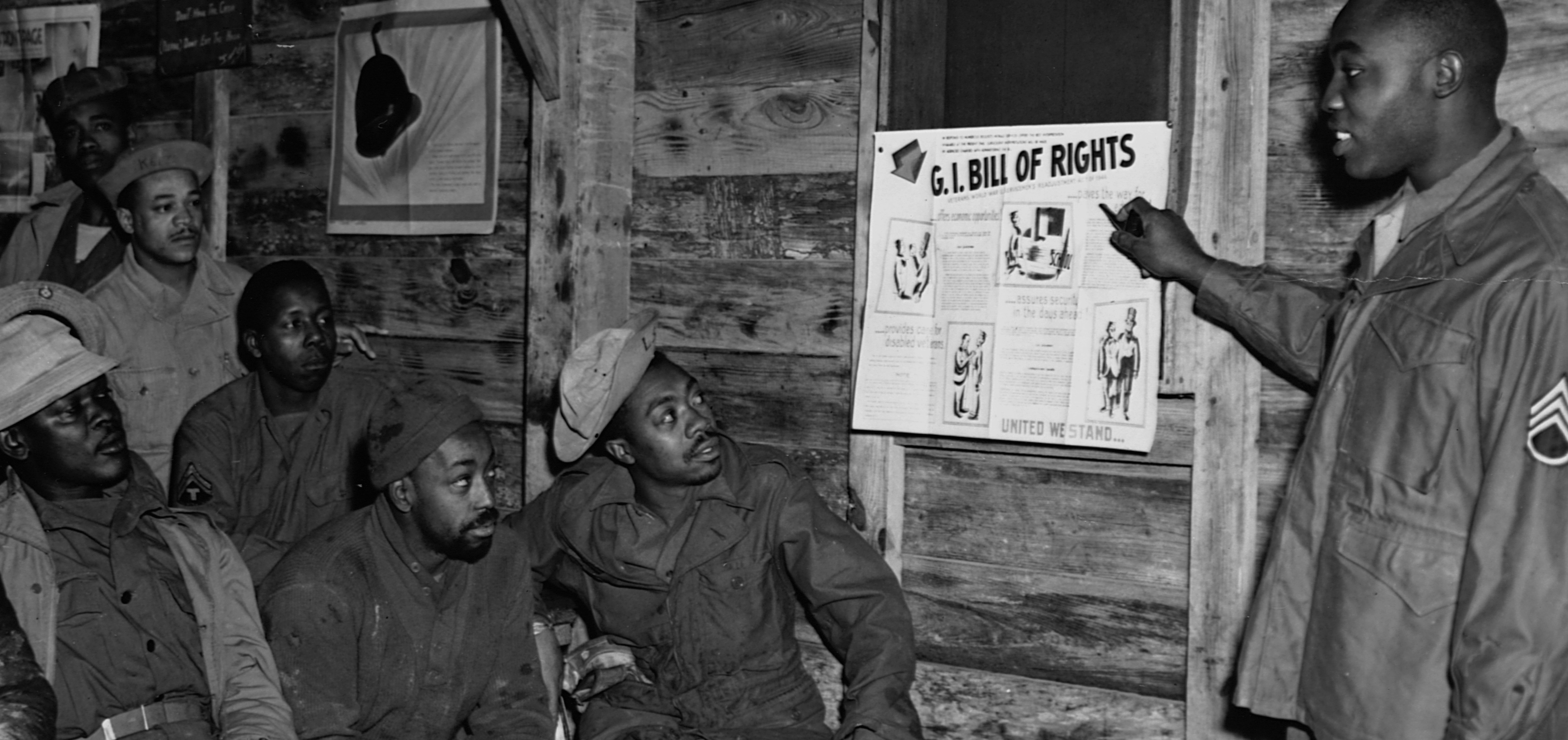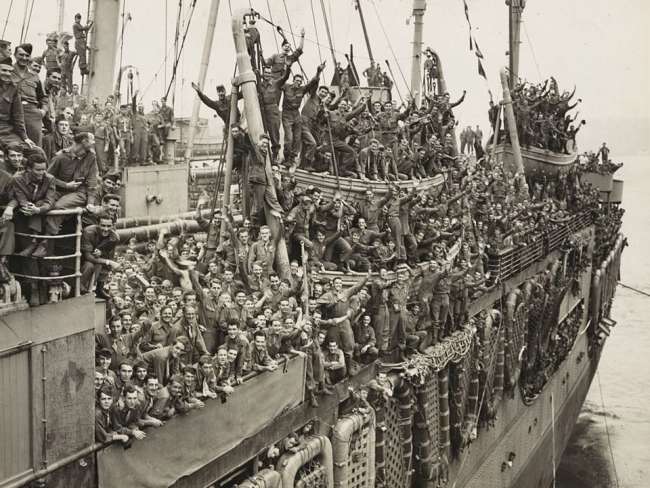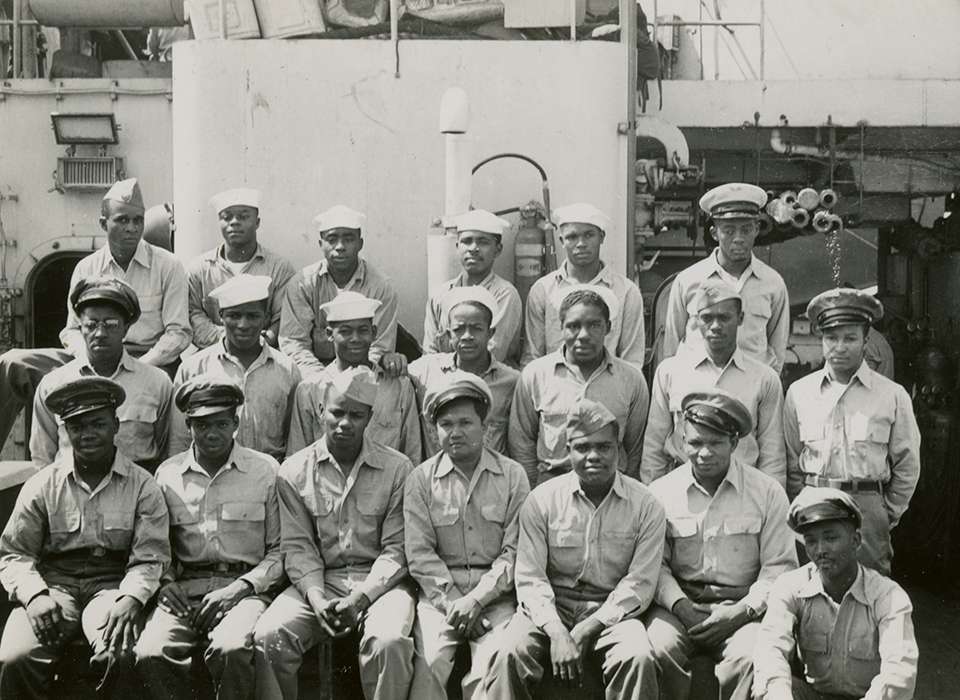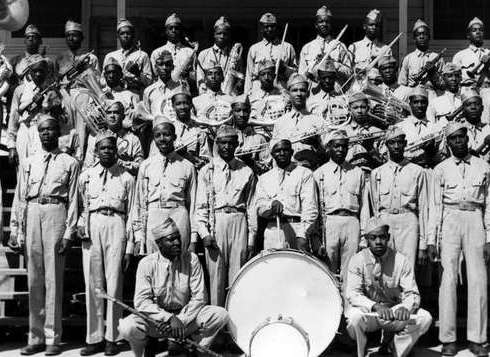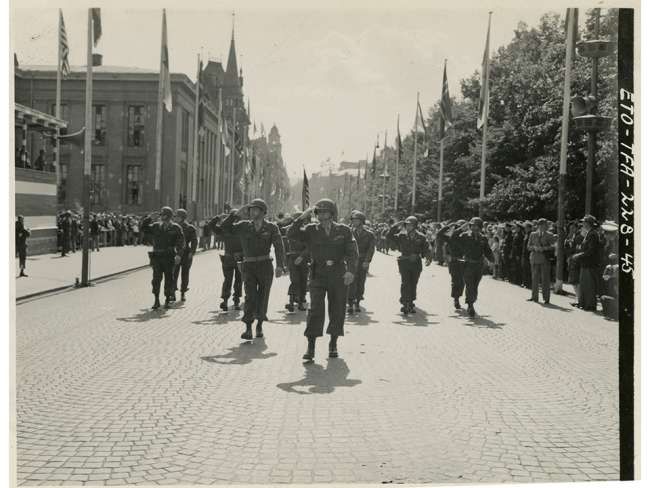Listen: Apple Podcasts, Spotify.
About the Episode
Allied victory had rescued humanity from a dark future, but for President Truman and his administration, the celebrations were short lived. There were still a number of challenges that remained, including the demobilization of millions of men and women, reshaping the economy without putting millions out of work, social unrest and growing racial tensions at home, and the looming threat of the nation’s burgeoning rivalry with the Soviet Union.
This week’s episode, hosted by the Museum’s Dr. Kristen Burton and written by executive producer Gemma R. Birnbaum, is this season’s finale, and sets the stage for next season’s exploration of the immediate postwar years and Truman’s legacy. The world in 1945 stood at a crossroads. For some, a freedom that they had never experienced before brought new opportunities, economic security, and stability. Thanks to new legislation like the GI Bill, many Americans experienced unprecedented access to education, home ownership, and jobs.
For others, the struggle was anything but over. Across eastern Europe, Stalin’s regime brought oppression, violence, and the ever-present eye of the secret police. Across Asia, the threat of Communism was real and growing. On the US Home Front, there were fears of another economic depression in the face of demobilization and converting back to a peacetime economy, all while the stark reality of racial inequality was brought to the forefront as Black, Jewish, Asian, and other American minorities returned home after the war to find that they were being denied their basic rights when it came to buying homes, finding jobs, and getting a decent education.
Season two of “To the Best of My Ability” premieres on November 20, 2020. Catch up on all episodes and be sure to leave us a review on your favorite podcast platform.
Topics Covered in this Episode
- Demobilization after World War II and Operation Magic Carpet
- The Aftermath of World War I
- The Servicemen's Readjustment Act of 1944, known as the GI Bill
- The President’s Committee on Civil Rights
- Truman’s Address to the NAACP
Featured Historian
Dr. Marcus Cox
Dr. Marcus Cox serves as Associate Dean, Graduate Programs and Summer School and Director of the Center for Continuing Studies and Distance Education in the College of Arts & Sciences at Xavier University of Louisiana. He earned an undergraduate degree in marketing and a master’s degree in history from Southern University and a master’s degree in business administration from The Citadel School of Business Administration. Dr. Cox received his doctorate degree in African American history from Northwestern University in Evanston, Illinois. Throughout his professional career, he has held leadership positions as Founding Director of the African American Studies, Assistant Dean of the School of Humanities and Social Sciences and Associate Dean of The Citadel Graduate College with leadership responsibility of Evening Undergraduate Studies. He holds the distinction of being the first African American faculty member appointed to the position of Dean in the 172-year history of The Citadel Military College of South Carolina.
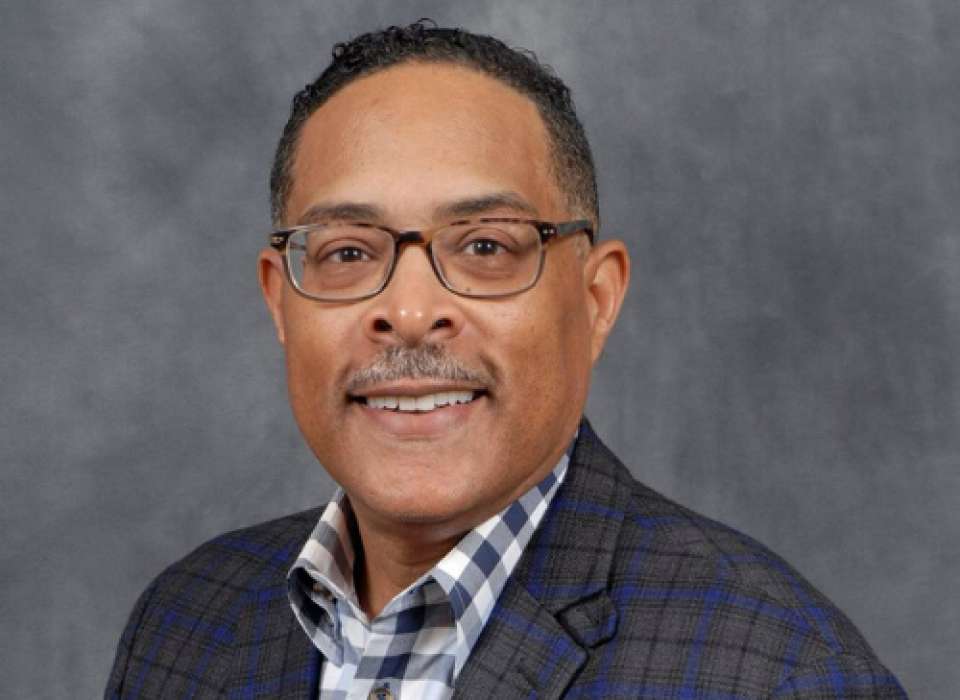
Related Content
-
Article Type
The Points Were All That Mattered: The US Army’s Demobilization After World War II
When World War II ended in Europe, American soldiers feverishly began calculating how soon they might go home based on a newly instituted point system.
-
Topic
African Americans in World War II
Explore profiles, oral histories, photographs, and artifacts honoring African American contributions to World War II from the Museum's collection.
-
Fighting for the Right to Fight in Louisiana with Dr. Marcus Cox
Join Marcus Cox, PhD, as he moderates a panel of historians and authors as they analyze the experiences that African Americans faced in Louisiana during World War II.
-
Article Type
Liberation and Legacy
Dr. Rob Citino highlights the moments of celebration, as well as realization of the repercussions that followed Allied victory and the end of World War II.
-
Contributor
Kristen D. Burton, PhD
Kristen D. Burton is the Teacher Programs and Curriculum Specialist at The National WWII Museum in New Orleans, LA.
Sponsors
"To the Best of My Ability" is part of an ongoing series commemorating the 75th Anniversary of the End of World War II made possible by The Nierenberg Family and Bank of America.
Transcript
Archival Audio - President Truman on Reconversion of the US Economy
1946 is our year of decision. This year, we lay the foundation of our economic structure, which will have to serve for generations. This year we must decide whether or not we should devote our strength to reaching the goal of full production and full employment. This year, we shall have to make our decisions, which will determine whether or not we gain that great future at home and abroad which we fought so valiantly to achieve. I wish I could say to you that everything is in perfect order, that we are on the way to eternal prosperity -- I cannot. The month ahead will be difficult. We are well along the rope toward our goal, but every turn, a risk of coming up on a barrier which can stop us. In the message to the Congress on September the 6th 1945 and in other messages, I have outlined legislative proposals to meet the problems which lie ahead.
Dr. Kristen Burton
Allied victory had rescued humanity from a dark future, but for President Truman and his administration, the celebrations were short lived. There were still a number of challenges that remained, including the demobilization of millions of men and women, reshaping the economy without putting millions out of work, social unrest and growing racial tensions at home, and the looming threat of the nation’s burgeoning rivalry with the Soviet Union.
Archival Audio - Truman Taking the Oath of Office
“I Harry S. Truman do solemnly swear to faithfully execute the Office of President of the United States, and will to the best of my ability, preserve, protect and defend the Constitution of the United States, so help me God.”
Dr. Kristen Burton
You’re listening to “To the Best of My Ability” from The National WWII Museum in New Orleans, and this is episode 9, “The Pool of Armed Might.” I’m your host, Dr. Kristen Burton.
This week, we begin our story with Operation Magic Carpet, as the United States worked to bring home nearly eight million military personnel who were scattered across every part of the globe.
Archival Audio - US Veterans Return Home
[Music]
Into New York Harbor comes a prize of war. The luxury liner Europa, once the pride of Germany. She is now a United States troop transport ship and as she arrives at dusk past the new york city skyline, she brings four thousand jubilant American soldiers back to their homes.
[Applause]
[Music]
A federal marshal takes over the 50 000 ton Europa. She is now to fly the stars and stripes and to carry many another veteran back from war.
Dr. Kristen Burton
At the end of World War II, the United States faced its first great challenge: how to get home the nearly eight million military personnel stationed overseas and transition those remaining into an occupation force. It had taken four years of war to send them abroad, and now millions of these men and women needed to come home in a matter of months.
In the days following V-E Day, the US Army began the initial phase of demobilization, all while the war still raged in the Pacific. Some soldiers were to remain in Europe as part of the occupation. Others were needed to redeploy for the anticipated invasion of Japan. Still, with a significant surplus of personnel, the Army had to identify and discharge millions of people who had been stationed in Europe.
Based on a point system calculated by length of service, number of battle stars, and number of children waiting back home, the Adjusted Service Rating Score was announced in September 1944, and within hours of Germany’s surrender, troops in Europe were eagerly calculating their scores. Though initially devised with the intent of finding an equitable way to decide reassignments, the point system was rife with misinterpretation, resentment, and proved to be an administrative nightmare. The priority was winning the war in the Pacific, so many soldiers in Europe faced long wait times as resources and efforts were directed to Asia. Morale was declining as month after month, soldiers continued to wait for their turn to go home.
Japan’s surrender on September 2, 1945 provided a glimmer of hope, and just four days later, Fleet Admiral Ernest J. King authorized the use of combat ships to bring Americans home. Through Operation Magic Carpet, the Army began discharging on average over one million troops per month and lowered the number of points needed to qualify from 85 to 50. By the end of 1945, more than four million Americans had been discharged and returned home. However, it wouldn’t be until June 30, 1947 that demobilization officially came to an end.
Joining us this week to discuss the postwar United States and the economic and social challenges Truman faced in the immediate aftermath of World War II is Dr. Marcus Cox, professor of history at Xavier University of Louisiana.
Dr. Marcos Cox
All Americans are elated that the war is over, and that there is a strong desire to, you know, to return to peacetime, to rejoin your loved ones, to have people at home. But—but also, I think, there is a level of anxiety about what’s going to happen next. How is America going to transition to a peacetime economy?
But when you think of the United States after World War II, a lot of people don’t realize how difficult it was to transition to a peacetime economy. And so Truman had, you know, several major challenges ahead of him. So, you know, the first challenge is that, you know, what he’s—what he really wants to do is reduce the level of federal expenditures in 1945-46, after the—after the war is over.
And so the first thing he does is to demobilize the military, which is a huge, you know, part of those expenditures. But by demobilizing the military and sending millions of men and women back to civilian society, of course, you have to create jobs.
Archival Audio - The GI Bill of Rights
Back in 1918, these were pretty exciting pictures -- the fighting men of America coming home from France. Down Fifth Avenue they marched with their brass shining and grins a mile wide. The crowds cheered and waved flags and the doughboys home from Chateau-Thierry and Belleau Wood land on picking up their lives just where they'd left them. Only for a lot of them, it didn't work out that way. Not exactly. Some of these marching men wanted to go back to school but discovered they didn't have the money. Others learned the job they'd left behind was gone or if they were there they didn't want them. They wanted something better. But for these returning soldiers, no legislation had been passed nor any program mapped out to give them the break they deserved. They got medals, but 15 years later some of these men were selling apples on street corners. Others were known contemptuously as bonus marchers.
[Explosion]
Are these Navy boys going to get the same sort of deal? What about this man who's fought the long tough fight up Italy and has been knocked out. What's gonna happen to him? Is it going to be the same for these GI’s hitting the beach in Saipan for the Siegfried line or the Gothic line or any line that's needed hitting? When it's all over is it gonna be like last time for them? No, this time it's going to be different. Yeah? What makes you so sure? Because in Washington, there was a group of congressmen with long memories who were in the last war. They knew that when a man gets out of the Army or Navy or Marines, he's worried most about a job and education and a home, and that's why Congress, led by the President, passed the law: the Servicemen's Readjustment Act of 1944, better known as the GI Bill of Rights.
Dr. Kristen Burton
The GI BIll provided veterans returning home from the war a wide range of benefits, including low-interest business loans, low-cost mortgages, unemployment compensation, and payments for tuition and living expenses for those who wished to finish high school or attend college or vocational school. The bill was created out of a desire to avoid the political problems that arose after World War I. Veterans of that conflict came home and received little support when it came to transitioning back to civilian life. Veterans organizations that formed after the war mobilized their millions of members to fight for Congress to pass a bill that put those benefits in place. By passing the GI Bill in 1944, there was also hope of helping to prevent another Great Depression -- an educated populace with job opportunities and money to spend would be good for the post-World War II economy.
Although the GI Bill did not outwardly advocate for discrimination, the law was designed to accommodate Jim Crow. MIssissippi Congressman John Rankin, well-known for his ardent support of segregation and his attempt to have all Americans of Japanese descent deported, insisted that the program must be administered by the states rather than the federal government.
As a result, many Black veterans and other minority groups had difficulty claiming some of their benefits when administered by local agencies. Black veterans returned home to the promise of a new life only to find they were still living under the same white supremacist laws that had prevented them from entering neighborhoods, universities, and job markets as before the war. Still, those who were able to claim their benefits, some 49% of all World War II veterans, saw it transform their lives.
Dr. Marcus Cox
The GI Bill had a—had a tremendous impact on the Black community. In particular, you know, many people would argue that the GI Bill is really responsible for building the black middle class beginning in the 1950s.
And I can—even personally, I can think of so many different stories in terms of my family and other people I know, where—individuals like my grandfather, who was able to go to college, and, you know, and my uncle, who was able to get a job in the US Postal Service because he served in the Navy and ended up retiring from, you know, from that job and putting all his children through college.
You also have a lot of—and of course, you know, one of my areas that I focus a lot on is the history of military training programs in black colleges. And I know for a fact that enrollment in—at HBCUs during the 1950s increased exponentially with—just about all HBCUs—because there were so many veterans that were returning and going back and getting their—their education or getting their high school diploma.
And there was probably as many or more individuals who were using the benefits to go to trade school and to—to get skilled training in different industries. And the GI Bill was able to pay for this. Now, normally, what would happen if—if benefits and resources were managed by the federal government, they were probably better distributed. If they had to be distributed by the state governments or local governments, that’s when African Americans would have difficulty receiving those type of benefits.
Dr. Kristen Burton
Though the GI Bill guaranteed veterans low-interest mortgages, it was not the VA, but white-run banks that administered these home loans. Changing demographics also meant that these problems were not relegated to the South. Discriminatory housing practices took place throughout the country. Idyllic suburban neighborhoods came with overtly racist and anti-Semitic covenants -- legally enforceable contracts that prohibited these groups from purchasing or leasing homes in certain neighborhoods.
Dr. Marcus Cox
After Americans returned from, you know, both theaters. They —they’re still in the uniform. And at that particular point, you have a rash of race riots and—and physical assaults, murders, and what have you that take place throughout the United States, but in particular, the South.
And on the other side, you have southern Americans who come back home and quickly want to reinstitute white supremacy and their dominance of the political process and also social and economic institutions, you know, throughout the South—in other words, to put African Americans back in their place.
This happened after the Civil War. It happened after World War I. It happened after World War II. And you—and I think, you know, a lot of people don’t discuss in terms of what happens in the North, because again, you have people who are returning in the North.
At this particular point, the North looks very different than it did in 1940 because in 1940, about 77% of African Americans lived in the South. By 1945, approximately 65% to 68% are living in the South. Which means that, you know, anywhere from 6% to 8% of the African American population has now moved up north and out west.
Dr. Kristen Burton
For many of the Black veterans and home front workers who had just spent years contributing to the fight against the world’s most powerful racist, being subjected to bigotry, violence, and a newly-empowered Ku Klux Klan spurred them to fight for civil rights at home.
Dr. Marcus Cox
So many of—of African-American civil rights leaders who returned in the 194—1945, ’46, almost immediately became active in the civil rights movement on a local and national level.
You have Medgar Evers in Mississippi. You have Hosea Williams, who was involved in organizing the Edmund Pettus crossing of the bridge or the—or the Selma march. You have so many others that I can name. And that—and that’s not—again, that’s not very unusual. You see the same thing that happens after the Civil War where many African American soldiers who served in Union regiments went back to the South.
They went back to their communities and they became very involved in politics, education, and civil rights activism in terms of, you know, voting rights. You see the exact same thing that happens after World War I. So I guess, you know, again, the military service encouraged those individuals to go back home and demand equal rights and opportunities.
You see a rash of social and racial unrest after World War II because you have so many African American men and women who are pushing the margins or the norm, so to speak, in their local communities as it relates to sitting in the back of the bus or trying to vote or trying to assert their—their rights as American citizens, and they almost always use their military service as—as the foundation of that right.
And so that—and I—and I think, again, that resonated very well with—with Truman. But also, you know, you see this level of activism that comes out of World War II which is, again, not completely different than in the past, but certainly is—is reignited. And, of course, obviously, some of the largest or most significant social civil rights advances that take place in the ‘50s and early ‘60s were led by military veterans from World War II.
Dr. Kristen Burton
In response to growing protests, as well as multiple high-profile attacks committed by law enforcement against Black veterans, President Truman signed executive order 9808, which created the President’s Committee on Civil Rights. Comprising a 15-member committee that included General Electric CEO Charles Edward Wilson, union leader James B. Carey, attorney and activist Sadie T. Alexander, and Rabbi Roland Gittelsohn, the committee was tasked with investigating and making a determination on how law enforcement and federal, state, and local governments could be improved to better safeguard the civil rights of all people. Ten months after their formation, the committee released their report. Titled “To Secure These Rights,” the report made a number of recommendations to the Truman administration, including abolishing the poll tax, an anti-lynching law, laws that would enforce fair housing, education, employment, and healthcare, and desegregating the military.
The committee’s work directly led to critical legislation in the fight for civil rights, including executive order 9980, which desegregated the federal workforce, and 9981, which desegregated the military.
The burgeoning Cold War also proved to be a catalyst for some of these social reforms. The world was watching, and soon after World War II’s end, America’s racism became a chief tenet in Soviet anti-US propaganda. Lynchings were no longer an act of domestic terror hidden with the confines of the nation’s borders. They were becoming an embarrassment on the international stage. Truman, the leader who had championed the United Nations and pushed for human rights around the world, could not prevent these crimes in his own backyard. He and his administration had to act.
Dr. Marcus Cox
So I think that, you know, right after the war is over, you know—I think a lot of people are looking at the future with a little bit of, like I said, anxiety or—or questioning what’s going to happen next. And I think also, on a—on an international front, you have the Cold War that’s really starting to heat up at this particular point.
I—I would often tell my students when I was teaching my class on social movements in the Vietnam era—I say, look, I say to them, 19—not as much in the 1940s during the war, but certainly after the Cold War starts, every time there was a race riot, every time there was an African American soldier that was murdered or—or killed for whatever reason, that story would end up in Pravda, the Soviet state newspaper.
And it was—it was mass-produced and distributed all over the world. And it made it very, very difficult for American diplomats in places like Africa, the Middle East, Asia, to go to those governments and say that, you know, they should embrace democracy because we have it—we’ve done it the right way. Oh, but by the way, ignore that story about the African American whose eyes were gouged out and—or the African Americans who were—who were murdered for trying to vote.
When we think of the Good War, we think of a time where—and as many people have described—you know, America’s Greatest Generation came together. They sacrificed. They fought together. They worked hard to overcome tyranny and totalitarian governments throughout the world to promote democracy and peace.
But what many people don’t remember or realize: the level of racial and ethnic discrimination in employment industries, the number of race riots that took place at that particular time. And a lot of the advances that African Americans made politically were really motivated by political expediency and the threat of mass demonstrations and marches that sort of encouraged, you know, those advances.
So there’s no question that, you know, not only African Americans, but many, you know, Americans were able to—to advance themselves in so many ways during this particular period, but it didn’t—it wasn’t based on moral or ethic—ethical motivations. It was more or less that—it wasn’t always good for everyone, put it that way. People struggled to—to advance in so many ways.
Archival Audio - President Truman Addresses the NAACP
Our immediate task is to remove the last remnants of the barriers which stand between millions of our citizens and their birthright. There is no justifiable reason for discrimination because of ancestry, or religion, or race, or color.
[Applause]
We must not tolerate such limitations on the freedom of any of our people and on their enjoyment of basic rights which every citizen in a truly democratic society must possess. Every man should have the right to a decent home, the right to an education, the right to adequate medical care, the right to a worthwhile job, the right to an equal share in making the public decisions through the ballot, and the right to a fair trial in a fair court.
[Applause]
We must ensure that these rights—on equal terms—are enjoyed by every citizen. To these principles I pledge my full and continued support.
[Applause]
Many of our people still suffer the indignity of insult, the narrowing fear of intimidation, and, I regret to say, the threat of physical injury and mob violence. Prejudice and intolerance in which these evils are rooted still exist. The conscience of our Nation, and the legal machinery which enforces it, have not yet secured to each citizen full freedom from fear.
We cannot wait another decade or another generation to remedy these evils. We must work, as never before, to cure them now.
[Applause]
Dr. Kristen Burton
From The National WWII Museum, I’m Dr. Kristen Burton, and this has been season one of “To the Best of My Ability.” Join us again in November when we return with brand new episodes.
This final episode was written by our executive producer Gemma R. Birnbaum. Media production manager Jeremy Burson did the sound mixing. Archival audio is courtesy of the National Archives. Our thanks to Dr. Rob Citino, Dr. Ed Lengel, Seth Paridon, Richard Frank, and Dr. Marcus Cox for their contributions this season. Special thanks to the Harry S. Truman Library, whose digital resources allowed us to continue production during the Covid-19 pandemic.
If you’ve enjoyed this podcast, please leave us a review. Reviews are important to help others find the series. "To the Best of My Ability" is part of an ongoing series of programs commemorating the 75th Anniversary of the End of World War II made possible by The Nierenberg Family and Bank of America.
